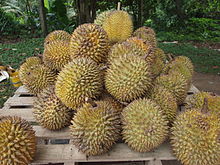Durian
| Durian | |
|---|---|
 |
|
 |
|
| Scientific classification | |
| Kingdom: | Plantae |
| (unranked): | Angiosperms |
| (unranked): | Eudicots |
| (unranked): | Rosids |
| Order: | Malvales |
| Family: | Malvaceae |
| Subfamily: | Helicteroideae |
| Tribe: | Durioneae |
| Genus: |
Durio L. |
| Type species | |
|
Durio zibethinus L. |
|
| Species | |
|
There are currently 30 recognised species (see the List of Durio species) |
|
 |
|
| Native distribution of D. zibethinus Exotic distribution of D. zibethinus | |
| Synonyms | |
|
Lahia Hassk. |
|
| Nutritional value per 100 g (3.5 oz) | |
|---|---|
| Energy | 615 kJ (147 kcal) |
|
27.09 g
|
|
| Dietary fiber | 3.8 g |
|
5.33 g
|
|
|
1.47 g
|
|
| Vitamins | |
| Vitamin A | 44 IU |
| Thiamine (B1) |
(33%)
0.374 mg |
| Riboflavin (B2) |
(17%)
0.2 mg |
| Niacin (B3) |
(7%)
1.074 mg |
| Pantothenic acid (B5) |
(5%)
0.23 mg |
| Vitamin B6 |
(24%)
0.316 mg |
| Folate (B9) |
(9%)
36 μg |
| Vitamin C |
(24%)
19.7 mg |
| Minerals | |
| Calcium |
(1%)
6 mg |
| Iron |
(3%)
0.43 mg |
| Magnesium |
(8%)
30 mg |
| Manganese |
(15%)
0.325 mg |
| Phosphorus |
(6%)
39 mg |
| Potassium |
(9%)
436 mg |
| Sodium |
(0%)
2 mg |
| Zinc |
(3%)
0.28 mg |
| Other constituents | |
| Water | 65 g |
|
|
|
|
|
| Percentages are roughly approximated using US recommendations for adults. | |
There are currently 30 recognised species (see the List of Durio species)
Lahia Hassk.
The durian (/ˈdjʊriən/) is the fruit of several tree species belonging to the genus Durio. The name "durian" is derived from the Malay-Indonesian languages word for duri or "spike", a reference to the numerous spike protuberances of the fruit, together with the noun-building suffix -an. There are 30 recognised Durio species, at least nine of which produce edible fruit, and over 300 named varieties in Thailand.Durio zibethinus is the only species available in the international market: all other species are sold only in their local regions. There are hundreds of durian cultivars; many consumers express preferences for specific cultivars, which fetch higher prices in the market.
Regarded by many people in southeast Asia as the "king of fruits", the durian is distinctive for its large size, strong odour, and formidable thorn-covered husk. The fruit can grow as large as 30 centimetres (12 in) long and 15 centimetres (6 in) in diameter, and it typically weighs one to three kilograms (2 to 7 lb). Its shape ranges from oblong to round, the colour of its husk green to brown, and its flesh pale yellow to red, depending on the species.
Some people regard the durian as having a pleasantly sweet fragrance; others find the aroma overpowering with an unpleasant odour. The smell evokes reactions from deep appreciation to intense disgust, and has been described variously as rotten onions, turpentine, and raw sewage. The persistence of its odour, which may linger for several days, has led to the fruit's banishment from certain hotels and public transportation in Southeast Asia.
...
Wikipedia
